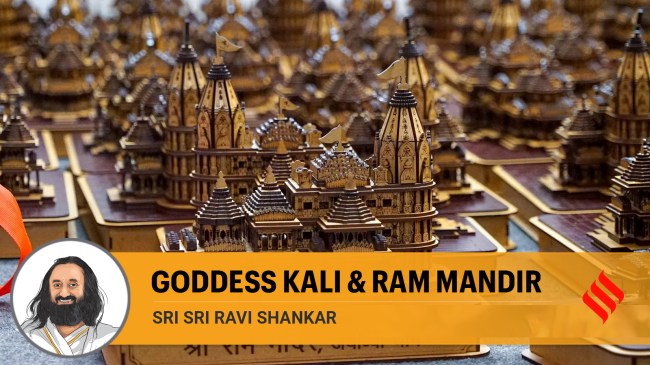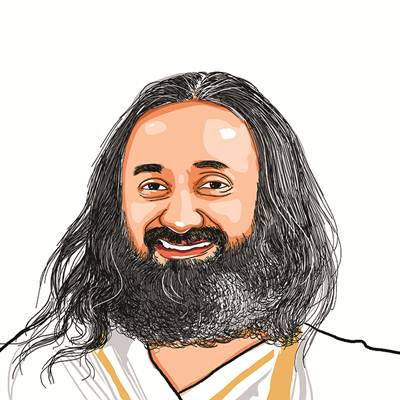Opinion Sri Sri Ravi Shankar writes: How a Kali temple ensured peace in Ayodhya
In a city rocked by communal violence, a prophecy showed the way
 "It wasn’t long before we discovered that there were, indeed, two Kali mandirs in Ayodhya. The first, in the heart of the city, was called Chhoti Devkali mandir while the second, slightly more distant, was known as the Devkali mandir," writes Sri Sri Ravi Shankar. (PTI)
"It wasn’t long before we discovered that there were, indeed, two Kali mandirs in Ayodhya. The first, in the heart of the city, was called Chhoti Devkali mandir while the second, slightly more distant, was known as the Devkali mandir," writes Sri Sri Ravi Shankar. (PTI) As the country prepares for the consecration of the Ram Temple in Ayodhya, a long-awaited dream is about to become a reality. It’s time to appreciate the role played by the Supreme Court, our prime minister and all the stakeholders. The saga around the Ram temple in Ayodhya is full of interesting anecdotes and mysteries.
In the summer of 2002, Ashok Singhal, then president of the Vishwa Hindu Parishad, came to meet me at our Bangalore ashram. He had arrived from Kanchipuram where he had met the erstwhile Kanchi Shankaracharya Sri Jayendra Saraswathi in connection with the Ram Janmabhoomi-Babri Masjid dispute. This was soon after the talks between the Shankaracharya and prominent Muslim leaders had failed. Singhal wanted then Prime Minister, Atal Bihari Vajpayee, to clear the path to build the Ram Mandir immediately. Some of his demands seemed impractical given that Vajpayee was running a coalition government.
Vajpayee and I had kept in touch on the Ayodhya issue ever since we met in 2001, following my return to India from the World Economic Forum (WEF). He had entrusted me with the task of finding a cordial settlement to the long-standing dispute. In response, I embarked on a series of discussions with influential members of the Muslim community.
At the time, Singhal was not on talking terms with Vajpayee, especially after the latter had him force-fed during his fast-unto-death campaign on the Ayodhya dispute. He had arrived at the ashram to persuade me to convince Vajpayee to introduce legislation to solve the Ram Janmabhoomi matter once and for all, even if it led to the collapse of the government. “I don’t care”, he said.
At 76, Singhal radiated a fervent spirit and the spark in his eyes displayed passion, righteous indignation and frustration. He asked me whether the temple would ever be built. I then intuitively felt that it would not happen for at least another 14 years. I remember telling him, “Pray for it and with your commitment, all is possible”.
The next morning during meditation, I had a vision of a dilapidated Devi temple with a pond that needed to be resurrected. I didn’t pay much heed to it then. A few days later, an elderly Nadi Siddhar from Tamil Nadu visited the ashram. As he read the ancient palm leaves, he said with gentle authority, “Gurudev, it is written that you will need to play a role in bringing both communities together to resolve the Ram Janmabhoomi issue.” He added, “The nadi leaves also reveal that a temple built for the Kuladevi (family deity) of Shri Rama, Devkali, is languishing in severe neglect. Unless it is restored, the strife surrounding the Ram temple in Ayodhya will not end”.
Neither Nadi Siddhar nor I were aware of the existence of such a temple. Enquiries were made. It wasn’t long before we discovered that there were, indeed, two Kali mandirs in Ayodhya. The first, in the heart of the city, was called Chhoti Devkali mandir while the second, slightly more distant, was known as the Devkali mandir – it was in ruins, with its central pond reduced to a dumping ground. I reached out to our volunteers to start work on renovating the temple and rejuvenating the pond. By mid-September, they had completed the task.
On September 19, 2002, the re-consecration of the Devkali temple took place. As I offered the purnahuti, I noticed tears of joy and gratitude in the eyes of the temple’s aged priest. Goddess Devkali was shining in all her glory.
Strangely enough, after the puja at the temple, the town has not witnessed any bloodshed or rioting due to communal violence. A prophecy had been fulfilled.
Later that evening, a Sant Samagam was held at the Devkali temple premises, to which we had invited both Hindu and Sufi saints. Over a thousand people joined in a satsang. Everyone collectively prayed for a peaceful resolution of the dispute. As I was honouring the Muslim leaders, they presented me with a copy of the Quran along with a book of the Tulsi Ramayan and spoke of their reverence for Ram. Their gesture strengthened my belief that only those with vested interests wanted the communities to stay divided.
Enough blood had already been shed in this age-old conflict and a resolution that would hold the test of time was needed. It was keeping this in mind that in 2003, I proposed an out-of-court settlement where the Muslim community could gift the Ram Janmabhoomi to the Hindus as a gesture of goodwill and the Hindus, in return, could gift them a five-acre plot of land for the construction of a mosque that they would help build. This would send a clear message of brotherhood.
After the Devkali Prana Prathista, Singhal invited me to his ancestral home in Allahabad. I told him that it is not human effort alone, but the Divine will too, that plays a role in the fructification of any action. And for that, we need patience. I hinted to him that he should not rush matters. By the end of the evening, he seemed much more relaxed and had softened in his stand against the Vajpayee government.
Years passed. In 2017, prompted by leaders from both communities and later the Supreme Court, I resumed my efforts to mediate in the Ram Janmabhoomi matter. Ultimately, the Supreme Court delivered its judgment allocating the said land for the construction of a temple and designating five acres for the construction of a mosque. It was a momentous occasion as a 500-year-old conflict reached a peaceful resolution.
There is an underlying subtle aspect to the matter. We tend to navigate the cause-and-effect dynamics within the realm of the tangible, seldom extending our perception beyond it. The truth is the forces of the subtle realm have a great say over what ultimately materialises in our physical world — another mystery of this enigmatic world that we inhabit.
The writer is a spiritual leader and founder of the Art of Living Foundation






